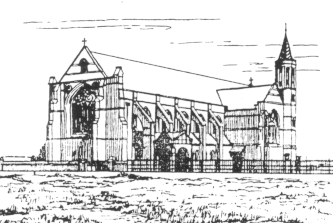
The History
of
Saint Faith's Great Crosby
This Church of Saint Faith
is dedicated to the glory of God as a thank offering for the revival of
Catholic Faith and Doctrine
in the Church of England during the sixty years reign of Her Most
Gracious Majesty Queen Victoria.
|
|
This inscription, carved high up in the chancel opposite
the organ, helps to explain why the Church was built and what it stood
for.
|
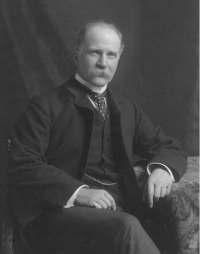 The history of Saint Faith`s Parish Church
obviously begins before there was a building on the site. During the
latter years of the 19th century the Anglo-Catholic movement in the
Church of England was working to bring to Anglicanism a greater
emphasis on order, discipline and on regular eucharistic worship. The
founder of Saint Faith`s, Howard Douglas Horsfall (picture right),
was a member of that Anglo-Catholic movement and it was at his
instigation that the church was built. He purchased a patch of land in
what was then mostly open ground and built a church which from the
start insisted on the centrality of the Eucharist or Communion service
and the use of vestments, candles and ornaments in worship. This
intention was not unopposed and a petition was sent to the Archbishop
of York asking him not to consecrate "this Mass House", whilst
militant Protestant demonstrators besieged the church from the outset -
a trend which, sadly, continued for some time. It has been said that
local bus conductors would shout "change here for Rome" when
their buses approached the stop near the church. In 1908 when a
visiting bishop set fire to his vestments on a pulpit candle there was
an opinion that this was a judgement on Saint Faith`s for using such
idolatrous adornments in the first place.
The history of Saint Faith`s Parish Church
obviously begins before there was a building on the site. During the
latter years of the 19th century the Anglo-Catholic movement in the
Church of England was working to bring to Anglicanism a greater
emphasis on order, discipline and on regular eucharistic worship. The
founder of Saint Faith`s, Howard Douglas Horsfall (picture right),
was a member of that Anglo-Catholic movement and it was at his
instigation that the church was built. He purchased a patch of land in
what was then mostly open ground and built a church which from the
start insisted on the centrality of the Eucharist or Communion service
and the use of vestments, candles and ornaments in worship. This
intention was not unopposed and a petition was sent to the Archbishop
of York asking him not to consecrate "this Mass House", whilst
militant Protestant demonstrators besieged the church from the outset -
a trend which, sadly, continued for some time. It has been said that
local bus conductors would shout "change here for Rome" when
their buses approached the stop near the church. In 1908 when a
visiting bishop set fire to his vestments on a pulpit candle there was
an opinion that this was a judgement on Saint Faith`s for using such
idolatrous adornments in the first place.
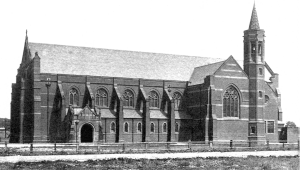
Saint Faith`s shortly after construction
. |
Although the legal name of the Church is Saint Faith`s, Great
Crosby the Church was actually built in an area covered by Waterloo
Urban District Council (now part of the Sefton Metropolitan District)
and is actually in the postal area of Waterloo, not Great Crosby. The
reason for the Great Crosby appendage to the name is that the field in
which the Church was built belonged ecclesiastically to Saint Luke`s
Parish, Great Crosby and hence the Ecclesiastical Commissioners have
always described the Church as Saint Faith`s, Great Crosby. At the turn
of the century when the church was constructed there was no housing
around but very soon new roads and houses were built and the church
became the centre of a close-knit community. |
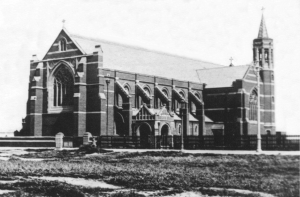
|
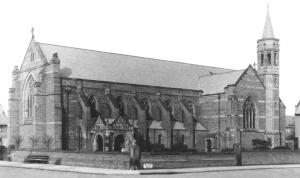
|
| St Faith`s in 1905. No housing has been built in the
vicinity and the church remains isolated. |
St Faith`s in the mid-1930s. The area has been developed,
a church hall has been constructed and housing surrounds the church
although there is still no vicarage. |
 The new Saint Faith`s banner
The new Saint Faith`s banner
Details of clergy at Saint Faith`s may
be found at the clergy page
Church Wardens
|
Name
|
Date
|
| J. Eshelby |
1900-1902 |
| J. Kendal |
1900-1901 |
| W.E. Taylor |
1900-1903 |
| J.S. Fairclough |
1902-1904 |
| W. Gay |
1903-1910 |
| G.W. Huson |
1904-1910 |
| S. Hawkyard |
1910-1911 |
| J. Cook |
1910-1916 |
| S.R. Taylor |
1911-1916 |
| W.A. Shaw |
1916-1919 |
| C.R. Whitnall |
1916-1917 |
| H. Cradock-Watson |
1917-1919 |
| H.J. Lister |
1919-1922 |
| R. Atcherley |
1919 |
| W.S. Kershaw |
1919-1920 |
| S.R. Taylor |
1920-1925 |
| R. Battersby |
1922-1925 |
| H.J. Lister |
1925-1926 |
| A. Studley |
1925-1947 |
| J.R. Mellick |
1926-1929 |
|
|
Name
|
Date
|
| C.H. Mossop |
1929-1938 |
| R.W. Jones |
1938-1957 |
| F.S. Smith |
1947-1953 |
| G.E. Waugh |
1953-1956 |
| A. Smith |
1956-1961 |
| J. Armstrong |
1959-1960 |
| D. Ryan |
1961-1962 |
| A. Smith |
1962-1963 |
| T.E. Williams |
1962-1965 |
| A. Clawson |
1963-1966 |
| L. Hamblett |
1965-1968 |
| A.F. Rigby |
1966-1967 |
| C.D. Price |
1967-2001 |
| G.W. Smith |
1968-1980 |
| R. Rankin |
1980-1985 |
| R.J. Walker |
1985-2001 |
| M.Davies |
2001- |
| J.Tudhope |
2001- |
|
During the 1960s the new Vicar, Rev. Charles Alfred Billington, upset
certain people with his ideas, including the organist, Ernest Pratt,
who resigned due to proposed changes in music to be used in services.
Father Charles, as he became known, went ahead with the changes which
included the introduction of incense and the Easter Vigil. He also
urged the congregation towards a more ecumenical approach. Saint
Faith`s has remained to the fore in its ecumenical approach and forms
one of a group of churches of different denominations in the local
Waterloo and Seaforth ecumenical group. Things have not always been
harmonious and in keeping with Saint Faith`s apparent tradition
protestors were on hand when the first Roman Catholic priest preached
at Saint Faith`s, or at any other Anglican church in Crosby for that
matter. Demonstrators from the Protestant Truth Society picketed the
church when Father Kennedy from Saint Edmund`s R.C. Church in Crosby
was invited to speak, and others tried to cause trouble when Arch
ishop Robert Runcie paid a visit to his old church.
Music formed a part of the worship at Saint Faith`s from the start
and the organ has been at the centre of the musical tradition. The
organ was not actually installed when the Church first opened and a
piano had to suffice for a while. Built by the Willis organ building
firm, this fine instrument has been restored twice over the years and
has been improved; its two sets of gilded and painted pipes may be seen
from the choir stalls and the Lady Chapel. The choir was originally a
male-only preserve but at times volunteers were in short supply. In the
parish magazine for June 1964 the organist bewailed the shortage of
choristers, "....any boy is free to join, irrespective of ability."
More recently females have been allowed to join the choir, which has
built an enviable reputation locally on radio and television; the most
recent broadcast being the Advent Service on Radio Merseyside on Advent
Sunday 1996.
During 1991 Saint Faith`s Day fell on a Sunday and it was decided to
celebrate our Patronal Festival by means of a "Celebration" of flowers
and music. The event lasted from Thursday until Sunday and the church
was decorated with flowers. Concerts, displays andexhibitions were
arranged and the church was open for visitors throughout each of the
days of the festival. On the Sunday, Saint Faith`s Day, Lord Runcie,
former Archbishop of Canterbury and an "old boy" of Saint Faith`s,
preached the sermon and celebrated mass at the morning Sung Eucharist.
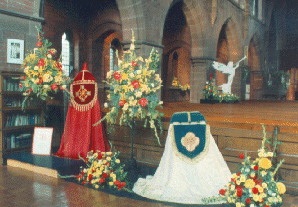
|
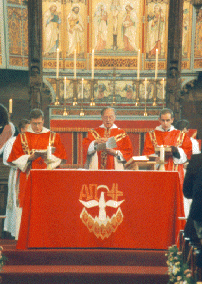
|
|
A view from the back of the church during the 1991
Festival: the view is looking towards the north aisle and shows
displays of flowers as well as the Angel sculpture specially
commissioned for the event.
|
Lord Runcie (centre), Rev Richard Capper and the Rev
Vivian Enever, at the Nave Altar with the High Altar and Reredos in the
background.
|
A more detailed history of St Faith`s covering its first 75 years may
be found in the book written by Chris Price to commemorate the 75th
anniversary of the church. This is available for download in pdf format
at the
History of St Faith`s 1900-1975 page.
Return to Saint
Faith's home page:


 The history of Saint Faith`s Parish Church
obviously begins before there was a building on the site. During the
latter years of the 19th century the Anglo-Catholic movement in the
Church of England was working to bring to Anglicanism a greater
emphasis on order, discipline and on regular eucharistic worship. The
founder of Saint Faith`s, Howard Douglas Horsfall (picture right),
was a member of that Anglo-Catholic movement and it was at his
instigation that the church was built. He purchased a patch of land in
what was then mostly open ground and built a church which from the
start insisted on the centrality of the Eucharist or Communion service
and the use of vestments, candles and ornaments in worship. This
intention was not unopposed and a petition was sent to the Archbishop
of York asking him not to consecrate "this Mass House", whilst
militant Protestant demonstrators besieged the church from the outset -
a trend which, sadly, continued for some time. It has been said that
local bus conductors would shout "change here for Rome" when
their buses approached the stop near the church. In 1908 when a
visiting bishop set fire to his vestments on a pulpit candle there was
an opinion that this was a judgement on Saint Faith`s for using such
idolatrous adornments in the first place.
The history of Saint Faith`s Parish Church
obviously begins before there was a building on the site. During the
latter years of the 19th century the Anglo-Catholic movement in the
Church of England was working to bring to Anglicanism a greater
emphasis on order, discipline and on regular eucharistic worship. The
founder of Saint Faith`s, Howard Douglas Horsfall (picture right),
was a member of that Anglo-Catholic movement and it was at his
instigation that the church was built. He purchased a patch of land in
what was then mostly open ground and built a church which from the
start insisted on the centrality of the Eucharist or Communion service
and the use of vestments, candles and ornaments in worship. This
intention was not unopposed and a petition was sent to the Archbishop
of York asking him not to consecrate "this Mass House", whilst
militant Protestant demonstrators besieged the church from the outset -
a trend which, sadly, continued for some time. It has been said that
local bus conductors would shout "change here for Rome" when
their buses approached the stop near the church. In 1908 when a
visiting bishop set fire to his vestments on a pulpit candle there was
an opinion that this was a judgement on Saint Faith`s for using such
idolatrous adornments in the first place.





